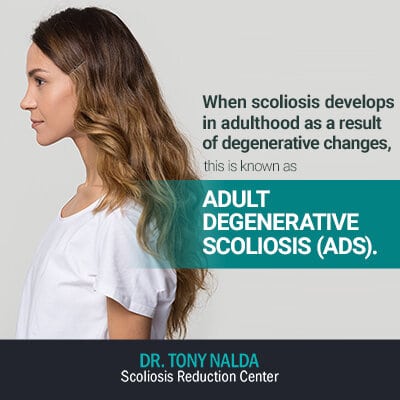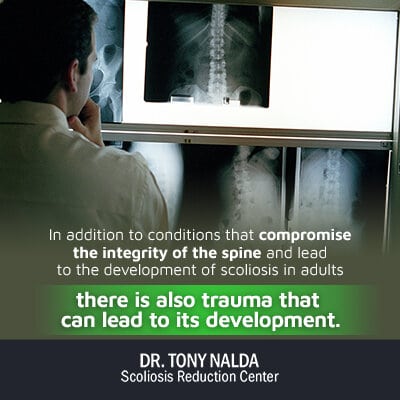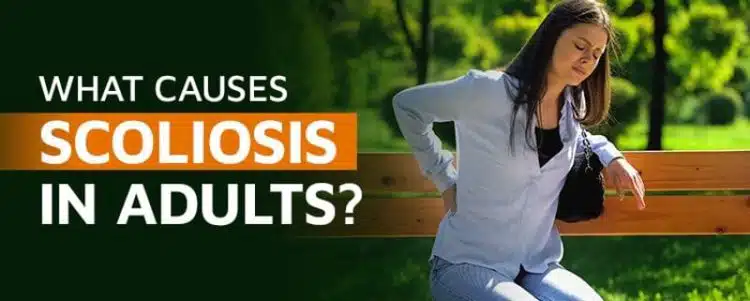Although scoliosis is most commonly diagnosed in adolescents between the ages of 10 and 18, adults can also develop scoliosis. While cases of adult ‘de novo’ scoliosis can develop, they’re far less common than cases of scoliosis carried from adolescence into adulthood. Additional causes of adult scoliosis include degenerative changes to the spine that can accompany aging, conditions that weaken the spine, trauma, and neuromuscular disease.
Scoliosis is not a simple condition to understand. It can take many forms and varies greatly from one patient to the next. In order to understand the most common forms of adult scoliosis, we’ll first take a look at why so many adult cases are carried from adolescence.
Diagnosing Scoliosis
While scoliosis can affect all ages, it’’s most commonly diagnosed in adolescents between the ages of 10 and 18, making it crucial to diagnose scoliosis early. One of the most challenging aspects of treating scoliosis is early detection.
Not only can adolescent idiopathic scoliosis (AIS) differ greatly in severity level from patient to patient, it has no known cause, and can also be very difficult to diagnose. This is because, for the largest group of patients with scoliosis (adolescents), pain is rarely part of their experience.
As this age group is constantly growing, the spine is experiencing a lengthening motion that counteracts the compressive forces of gravity. While this lack of pain is a good thing for those experiencing it, the flip side is that it makes it harder to diagnose; pain tells us that something wrong is happening within the body.
For adolescents, depending on how severe their condition is, without that big signifier, they are often unaware the condition is present. Also, the postural changes that scoliosis can cause can also be subtle and difficult for the average person to spot.
What this means is that many adolescents with the condition progress through adolescence into adulthood. It’s once they’ve reached skeletal maturity and the condition has progressed in severity that the condition’s symptoms become more noticeable.
Idiopathic Adult Scoliosis
When adolescent idiopathic scoliosis progresses into adulthood undiagnosed, it becomes known as idiopathic adult scoliosis, and this is by far the most common form of adult scoliosis.
Most often, it’s pain that brings adults in to see me, and then we reach a diagnosis. Once growth is no longer a factor, an abnormal curvature of the spine causes compression of the spine, its tissues, nerves, and surrounding muscles. This compression can cause back pain and radiating pain into the legs and feet.
In some cases, what starts as mild scoliosis can progress into more severe forms if left untreated.
The challenge of early detection is the reason so many adolescents grow into adulthood without knowing they have scoliosis, which is why so many cases of idiopathic adult scoliosis are actually cases of AIS that were undiagnosed and untreated.
While many cases of adult scoliosis follow this pattern, there are instances of adults who develop the condition fresh in adulthood with no prior history, and that’s referred to as adult ‘de novo’ scoliosis.
Adult De Novo Scoliosis
As discussed, true cases of adult de novo scoliosis are far less common than cases of idiopathic adult scoliosis. ‘De novo’ means new, meaning the patient didn’t have scoliosis in the past.
When a person develops scoliosis in adulthood, with no prior history, it’s often later in life, after the age of 40, commonly caused by spinal degeneration. This is due to degenerative changes to the spine that can accompany aging.
Degenerative Changes to the Spine

As a person ages, the spine’s vertebrae, ligaments, and discs can face degenerative changes, weakening the spine and causing it to curve abnormally. Many de novo cases are caused by the weakening of the facet joints and discs of the lower spine; this can lead to a shift that causes the spine to slip out of alignment and scoliosis to develop. When scoliosis develops in adulthood as a result of degenerative changes, this is known as adult degenerative scoliosis (ADS). Effective strategies to manage adult scoliosis often involve addressing these degenerative changes through various treatments.
Common symptoms of ADS include muscle fatigue, back pain, radiating pain into the legs and feet, and feelings of stiffness or numbness in the back and legs. In severe cases, posture can also be affected.
A diagnosis of ADS is most often reached through performing a physical exam/visual assessment, inspecting the patient’s medical history for any pathology, and reading their X-ray images.
As a result of the degenerative changes to the spine that can accompany aging, there are a number of conditions that can develop and contribute to the development of adult degenerative scoliosis.
Conditions Connected to Adult De novo Scoliosis
If scoliosis develops in adulthood with no prior history of the condition, it’s generally as a secondary complication of other medical issues and conditions: osteoporosis, vertebral compression fractures, spinal stenosis, trauma, or neuromuscular disease. In some cases, surgical options may be necessary to treat scoliosis effectively.
Osteoporosis
Osteoporosis is a common condition linked to the development of adult scoliosis and is caused by a loss of bone mass, basically making the bones thinner. Conditions that weaken the vertebrae of the spine can lead to the development of an abnormal spinal curvature as the spine’s ability to support itself is compromised.
Women going through menopause are more likely to develop osteoporosis because of the loss of bone mass, plus hormonal changes, that occur.
Osteoporosis can also lead to vertebral compression fractures, and these are also connected to the development of adult degenerative scoliosis.
Vertebral Compression Fractures
Vertebral compression fractures (VCFs) happen when the vertebral body of the spine collapses. When the spine is in a weakened state due to a loss of bone mass, it’s much more vulnerable to fractures. VCFs present with severe pain and discomfort and can lead to the development of adult scoliosis.
Fractures of this nature commonly happen in the lower portion of the thoracic spine (middle back), and the thoracic spine is also where many forms of scoliosis commonly develops.
The occurrence of vertebral compression fractures increases with age and is more common in women due to the natural bone-mass loss and hormonal changes that accompany menopause.
Another spinal condition that can lead to the development of scoliosis in adults is known as ‘spinal stenosis’.
Spinal Stenosis

With spinal stenosis, the spine’s vertebrae, along with surrounding tissue, can extend into the spinal canal and compress the nerves as they’re exiting the spine. This can occur in a single vertebra or multiple vertebrae.
Stenosis can impair mobility, is painful, and decreases muscle control and strength. It interferes with the function of the spinal cord, and that can throw off the spine’s biomechanics and lead to the development of spinal deformities like scoliosis.
In addition to conditions that compromise the integrity of the spine and lead to the development of scoliosis in adults, there is also trauma that can lead to its development.
Trauma
When the spine’s architecture is altered due to some kind of trauma, an abnormal curvature can develop as a result. This form of adult de novo scoliosis is often the result of a serious spinal fracture or break.
Traumatic scoliosis can also be caused by injuries to structures other than the spine itself, such as surrounding muscles and tissues that are needed to support the spine and keep it aligned.
Spinal surgery that leaves the spine unbalanced can also lead to the development of traumatic scoliosis.
Neuromuscular Disease
While this is a rare form of adult de novo scoliosis, neuromuscular diseases such as cerebral palsy, polio, and muscular dystrophy can also lead to the development of scoliosis.
When the muscles surrounding the spine aren’t working properly, the spine isn’t supported adequately; this can throw it off balance and out of alignment.
Risk Factors for Adult Scoliosis
Several risk factors can increase the likelihood of developing adult scoliosis. Age is a significant factor, with the condition being more common in older adults, particularly those over the age of 60. A family history of scoliosis also raises the risk, suggesting a genetic predisposition. Degenerative changes, such as wear and tear on the spine, can lead to a form of scoliosis called degenerative scoliosis. Traumatic injuries, like those sustained in car accidents, can alter the spine’s structure and cause scoliosis. Additionally, underlying medical conditions such as osteoporosis and spinal tumors can compromise spinal integrity and increase the risk of developing scoliosis.
Scoliosis Symptoms in Adults
Adults with scoliosis may experience a range of symptoms that can impact their daily lives. Back pain is the most common symptom, varying from mild discomfort to severe, debilitating pain. Leg pain is also prevalent, often resulting from nerve compression in the spine, leading to sensations of numbness and tingling. Muscle weakness in the back and legs can occur due to the same nerve compression. In severe cases, scoliosis can limit mobility, making it difficult to walk and perform everyday activities. Recognizing these symptoms is essential for early diagnosis and effective treatment.
Treatment Options for Adult Scoliosis
Treatment for adult scoliosis depends on the severity of the condition and the individual’s symptoms. Physical therapy is a common non-surgical option, involving gentle exercises and stretches to relieve pain and improve mobility. Pain management strategies, including medications and injections, can help manage pain and inflammation. In severe cases, scoliosis surgery may be necessary to correct the spinal curvature and alleviate nerve pressure. Each treatment plan is tailored to the patient’s specific needs, aiming to relieve pain and improve quality of life.
Managing Adult Scoliosis
Managing adult scoliosis requires a comprehensive approach that includes several lifestyle adjustments and medical interventions. Regular exercise, such as yoga and Pilates, can enhance flexibility and strengthen the muscles supporting the spine. Maintaining good posture is crucial to reduce strain on the spine and prevent further curvature. Effective pain management, in collaboration with a healthcare provider, is essential to control pain and inflammation. Regular check-ups with a healthcare provider are important to monitor the condition’s progression and prevent complications. By adopting these strategies, individuals with adult scoliosis can manage their symptoms and maintain a better quality of life.
Conclusion
When people think of scoliosis, they think of children and adolescents, but adults can also develop various forms of the condition. In fact, the occurrence of scoliosis actually increases with age. Adult scoliosis can be divided into two main categories: idiopathic and de novo.
Idiopathic adult scoliosis is by far the most common form as this involves cases of adolescent idiopathic scoliosis that were undiagnosed and untreated during adolescence. When those adolescents reach skeletal maturity, the condition’s symptoms, mainly pain, become more noticeable and lead to an official diagnosis.
When an adult patient develops scoliosis with no prior history, this is referred to as adult de novo scoliosis, and there are a number of causes for this: degenerative changes to the spine that can lead to osteoporosis, vertebral compression fractures, and stenosis. Less common causes include trauma and neuromuscular disease.
It used to be thought that scoliosis was solely a concern for those who hadn’t yet reached skeletal maturity; this turned out not to be the case. We’ve learned that idiopathic scoliosis that first appears during adolescence can continue progressing into adulthood, and as age increases, so too does the likelihood of curvature progression.
Regardless of the cause of adult scoliosis, here at the Scoliosis Reduction Center®, we have a number of effective treatment options available, and it’s never too late to seek treatment.





